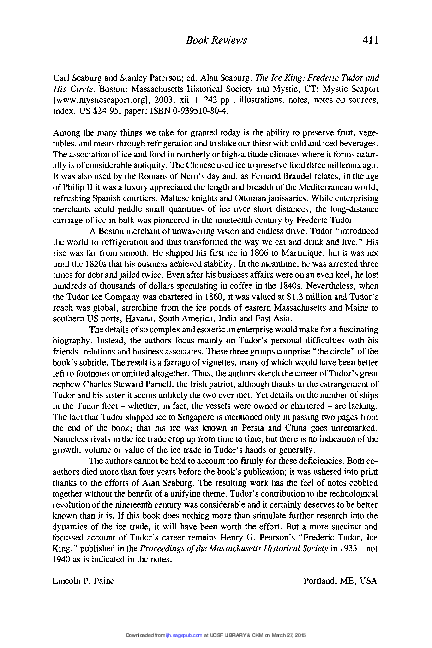Academia.edu no longer supports Internet Explorer.
To browse Academia.edu and the wider internet faster and more securely, please take a few seconds to upgrade your browser.
Book Review: The Ice King: Frederic Tudor and His Circle
Book Review: The Ice King: Frederic Tudor and His Circle
2003, The International Journal of Maritime History
Related Papers
Renaissance Quarterly 64 (2011): 992-994
Tudor Books and Readers: Materiality and the Construction of Meaning, ed. John N. King (Cambridge: Cambridge University Press, 2010)2011 •
History, Fiction, and The Tudors: Sex, Politics, Power, and Artistic License in the Showtime Television Series
Fact, Fiction, and Fantasy: Conspiracy and Rebellion in The Tudors2016 •
Michael Hirst, creator and writer of The Tudors, weaves conspiracy and rebellion into the plotline from beginning to end. Among the many story lines are the 3rd Duke of Buckingham’s alleged conspiracy to overthrow Henry VIII, a fictitious papal plot to kill Anne Boleyn, Thomas Cromwell’s very real conspiracy to remove her from power, the most dangerous rebellion that any Tudor monarch faced—the Pilgrimage of Grace of 1536–1537—and the Exeter Conspiracy. In assessing the series’ depiction of these and other events, it is important to keep in mind that Hirst’s primary objective was to produce an entertaining series, which he certainly did. However, if portions of his story have some historical basis, he often abandons proven fact, fictionalizing history or indulging in outright fantasy and leaving his viewers to decide which is which.
The human mind is complex and astonishing. It is the control centre for everything we do, believe and hope for. Through the analyses of primary sources, it is possible to understand the mental health of the Tudor Royal Family and have some insight into the way they behaved as they did.
DARING DYNASTY: Custom, Conflict and Control in Early-Tudor England
"LIKE FATHER, LIKE SON"? EXPLORING THE ACTIONS OF HENRY VIII THROUGH THE LENS OF HENRY VII2018 •
There have only been occasional scholarly toe-dipping into the complex and highly-speculative murkiness about Henry VII and his son, Henry VIII, regarding how much the former influenced the latter in ruling England. Pop psychology has been a favorite if at times facetious exercise when talking about Henry VIII. It ranged from his bevy of wives and a superego emerging in wars with France, to vengeful executions and playing ministers and supporters against each other on royal whim if not pathology. It was while reading about Henry VIII’s building and renovation of manors and castles that I came across the Whitehall Mural. As might be expected, much discourse about the mural had centered on Henry VIII’s overpowering image in this Holbein work that adorned the king’s privy chamber at Whitehall Palace until it burned down in 1698. It was the portrayal of a king that relegates the other three figures in it—his third wife, father and mother—almost to the shadows. This paper reviews certain actions of the son in full view of the accomplishments of his father, using the generally-ignored Whitehall inscription as a clue to the mind of the second Tudor king. It could be argued that the son competed with his dead father his entire life, a competition he could never win.
Journal of British Studies
John Guy. The Children of Henry VIII. Oxford: Oxford University Press, 2013. Pp. 272. $27.95 (cloth)2014 •
RELATED PAPERS
9th Research in Engineering Education Symposium (REES 2021) and 32nd Australasian Association for Engineering Education Conference (REES AAEE 2021)
How do Teachers Respond to Sustained Change?2022 •
CERN European Organization for Nuclear Research - Zenodo
Hilmizâde İbrahim Rifat ve Esâsü'l-Ahlâk2022 •
European Journal of Public Health
The impact of the crisis on the migrant population: the Spanish case2014 •
The ESPecialist
A implantação do NucLi UFS e a formação inicial de professores: realidades e possibilidades2020 •
The Journal of Physical Chemistry B
Autofluorescence of Condensed Heme Aggregates in Malaria Pigment and Its Synthetic Equivalent Hematin Anhydride (β-Hematin)2009 •
Institute of Arctic and Alpine Research (INSTAAR)
Human Paleo-Genomics and beringian landscapes2021 •
2021 •

 Lincoln Paine
Lincoln Paine